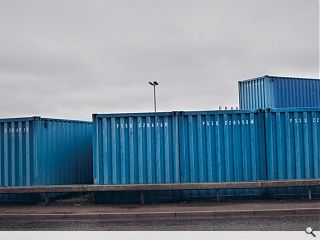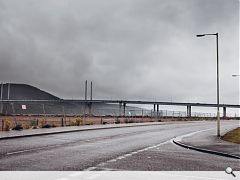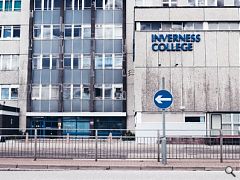In-a-mess
7 Oct 2010
Pulling into Inverness Station it was as though we had been quietly re-routed mid journey and diverted back to Glasgow Queen Street, so similarly awful is the Falcon Square mall to Buchanan Galleries, stepping out onto the less than salubrious concourse area we rather wished we had. As a gateway to the Highlands this space is sorely lacking with the same coterie of pan handlers and drifters in evidence that we thought we had left behind in the central belt. Expectations were subsequently set at a very low ebb, but perhaps this was just as well for outwith a few blocks of well preserved Victoriana in the city centre and a fine riverfront there is little on offer here to get the pulse beating. Instead we found a city smothered in a suffocating film of low density and dislocated suburban expansion.
It was a sensation not aided by the horizontal rain which greeted our arrival, and it nearly wasn’t an arrival at all after flooding, lightning and a derailment conspired to delay our trip by two hours. Ill disposed or not it soon becomes apparent that to get anywhere in this town was going to require a car and the only driving going on was by the rain. The solution required a tortuously circuitous round trip for the pedestrian to the “monoculture” of car showrooms along Harbour Road, a ramshackle avenue of warehouses whose ill thought through appearance irked Mark Chalmers who remarked: “Whilst their contents embody high technology, with the integration of steel, alloy and composites into expressive shapes … the containers are tin sheds dropped from outer space. If a masterplan had been put in place, the showrooms could have been a series of pavilions in white and silver with a common eaves height, and set on the same building line, each with a colourful totem out front identifying the dealership. I’ve seen it done in Germany, and it need not have cost any more than the random boxes on Harbour Road today.”As we fanned out across the city however a mix of stand-out buildings became apparent, each either: “relatively bad, relatively ordinary or relatively good,” noted Chalmers, who singled out Page & Park’s copper vortex-shaped Maggie’s Centre in the grounds of Raigmore Hospital; the nearby Gala Bingo hall at the entrance to the Beechwood Medipark; Inverness College’s “blank concrete box” across the road from the car showrooms; the “big, dumb, abandoned sheds” of Gray's Sawmill; and the burnt-out hulk of Craig Dunain Asylum, which awaits conversion into flats for honourable and dishonourable mentions.
Recent initiatives, such as the Highland Housing Fair, serve as belated acknowledgement of this drift and are attempting to raise expectations for the rest of Inverness by bringing low energy construction to greater prominence throughout the rest of the country. It’s a changed perception of construction which cannot come soon enough for a city commonly referred to as the fastest-growing in Europe, albeit one that has suffered as much as benefited from this rapid growth. Chalmers observed: “…an objective look around Inverness suggests that growth has resulted in homogeneous retail and housing estates on the outskirts: whilst they’re not wonderful architecture, they are no different to what you find in every other Scottish town and city. In search of what prompted someone to nominate Inverness for the Carbuncles, you may come to the conclusion that the town suffers from a low standard of ordinariness.”
Chalmers continued: “Given Inverness’s growth, and how busy the town appears even during this recession perhaps investment will sort out the bad in due course, and bring it level with the standard of ordinariness in the rest of the city. As it is, the likes of Inshes Retail Park is typical of Inverness’s periphery: none of it is terrible, but if you travel even half a mile outwards, the character of the old town centre has been surrendered completely to very ordinary retail sheds and car parks.”
Drew Mackie added: “The focus in Inverness was on the suburbs - the rapid expansion of housing and associated suburban shopping. The picture here is depressingly familiar: sprawling housing estates whose visual features are mainly drawn from the Home Counties, vast commercial sheds surrounded by a sea of car parking and a movement system that demands a car. OK, Inverness is growing fast and the demand for housing is great. But the very character that is attracting incomers is being eroded by this creation of a posse quality urban edge.
“At the Tornagrain charrette, a number of local people said that they did not want a repeat of what was happening in Inverness. Indeed some of the support for the eventual proposals may have come from a relief that the new settlement was to have a distinct visual character grounded in the Scottish vernacular.”
As Mackie notes: “Inverness is not in the same carbuncle league as Lochgelly, John o' Groats or Denny although it may have the potential to become so,” for the Carbuncles team weighing up a potentially dim future with past glories proved to be a difficult balancing act but one which, for the moment, remains somewhat tilted In Inverness’s favour. The city cannot continue to live off past glories however and as the built environment continues to degrade those qualities which have made the Highland capital irresistible to incomers could be lost. Not a Carbuncle in 2010 then but perhaps the real test for Inverness is whether it is awarded the title in future years.
|
|





